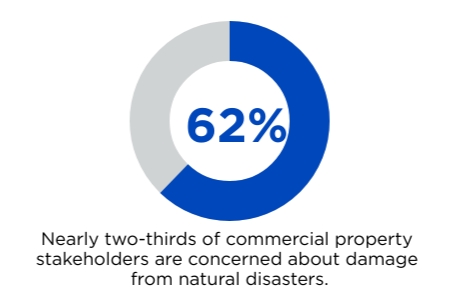Nationwide survey: widespread concern about the toll of severe weather
The toll weather has taken on the nation in recent years is immense.
Extreme weather events since 2017 have caused more than $1 trillion in total damage costs, or an average of more than $168.5 billion a year. That average is nearly triple the inflation-adjusted annual average of weather disasters for the previous 42-year period.1
As 2023 draws to a close, severe weather continues to make history. There have been a record 25 billion-dollar disasters (events that generate property losses of at least $1 billion). The total cost of these events is more than $73 billion.2
This rise in damage costs underscores the need to have plans in place to help mitigate damage, and also to have appropriate coverage if an event occurs. A recent Nationwide Agency Forward survey of agents and commercial property owners about severe weather and building codes indicates there is a need for conversations on this issue.
Results of the survey show fewer than half of agents (42%) say they are providing their commercial clients with carrier resources for protecting against severe weather. In addition, the majority of agents (67%) said between 40-60% of their commercial clients do not have adequate coverage.
Gaps in coverage can lead to situations where businesses or commercial property owners may face large out-of-pocket costs if a loss does occur, which underscores the importance of reviewing policies to verify customers are properly insured to value.
The extent of how much weather has impacted businesses is reflected in further findings of the survey.
Growing concern about severe weather
An analysis of annual reports over the last 30 years shows that weather is increasingly mentioned as having an impact on business results.3 In 1994, the report shows that only 25% of businesses mentioned weather as impacting business results. By 2018, that segment climbed to 65%, indicating a growing impact across a wide range of industries.

Nationwide’s survey data follows this trend: There is widespread concern about extreme weather and the potential it has to disrupt business and destroy property.
According to our survey, nearly 70% of commercial lines agents and 62% of commercial property stakeholders are concerned about the risk natural disasters pose to structures, personal property, and electrical systems.
This concern is warranted given how long it can take to recover, and how much it can cost during that process. Almost half (49%) of commercial property owners reported costs between $20,000 and $50,000 to repair damages, and the same share reported a total recovery time of four to six months.
Weather threats
More than a third of commercial property owners (36%) have reported damage from a natural disaster in the last five years.
The top 10 events that caused damage were:
- Tropical storm/hurricane – 42%
- Flood – 30%
- Tornado – 29%
- Wildfire – 17%
- Severe heat wave – 14%
- Damaging winds – 12%
- Lightning – 10%
- Earthquake – 9%
- Drought – 6%
- Ice storm/cold wave – 6%

Commercial property owners are most worried about structural damage, roof damage, broken windows and business interruption as a result of severe weather. According to our survey data, property stakeholders nationally reported that the top 10 types of damage or loss were:
- Structural damage – 52%
- Business interruption – 50%
- Roof damage – 49%
- Personal property damage – 39%
- Damaged electrical systems – 38%
- Broken windows – 38%
- Water intrusion – 34%
- Fallen/uprooted trees – 28%
- Foundation damage – 26%
- Damaged plumbing systems – 21%
There also is wide agreement about the need to make buildings more resilient as damage costs of these weather events continues to mount. Nationwide’s survey shows virtually all property stakeholders (99%) believe code compliance is vital for protecting property from severe weather damage.
Commercial property owners also indicate that they are committed to taking preventive measures. More than half (53%) say they would be willing to spend more to increase their structure’s resiliency to withstand extreme weather, according to the Nationwide survey.
Action to take
Any business can be impacted by severe weather, and a comprehensive risk management plan should be developed to address the specific risks each business faces. According to FEMA, about 40% of businesses do not open immediately after a disaster, and another 25% fail within one year4.
Nationwide has resources that help businesses address the risks they face, and an important first step is to develop a business continuity plan. Implementing a business continuity plan is a critical step for organizations to help identify exposures and take action to protect their operations.
Even if a business states that they have a continuity plan, it should be reviewed as organizations and their needs evolve. Reviewing the continuity plan and performing tabletop exercises can help note strengths and weaknesses. Vulnerability and risk assessments can also uncover additional needs, especially if the business conducts operations or has facilities in other regions of the country that may have different risks.
Mark Berven, President and COO of Nationwide Property & Casualty, and Sean Kevelighan, President and CEO of the Insurance Information Institute (Triple I), recently sat down to talk about protecting homes, businesses and communities from severe weather and the importance of resiliency.
Watch the video: Opportunities to enhance risk management for commercial business
Here are some resources that can help businesses understand the weather threat and implement protection strategies:
Materials on mylosscontrolservices.com can be shared with customers to help educate them about severe weather events, prepare for emergencies, and establish business continuity plans.
Citations/Disclaimers
-
3
Nagar, Venky and Schoenfeld, Jordan and Schoenfeld, Jordan, Measuring weather exposure with annual reports (August 5, 2022). Review of Accounting Studies, Forthcoming, Available at SSRN: https://ssrn.com/abstract=3438428or http://dx.doi.org/10.2139/ssrn.3438428

